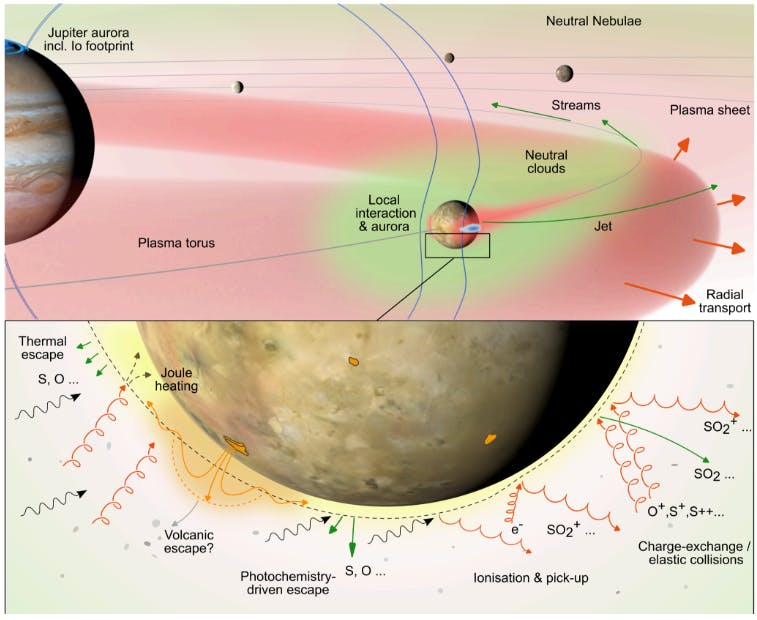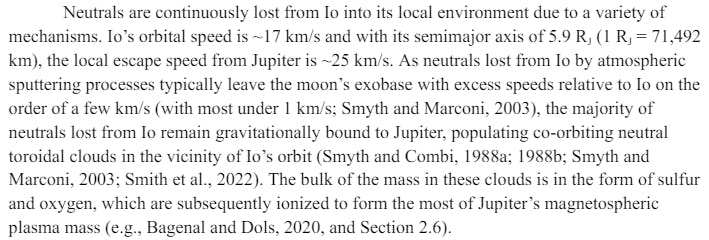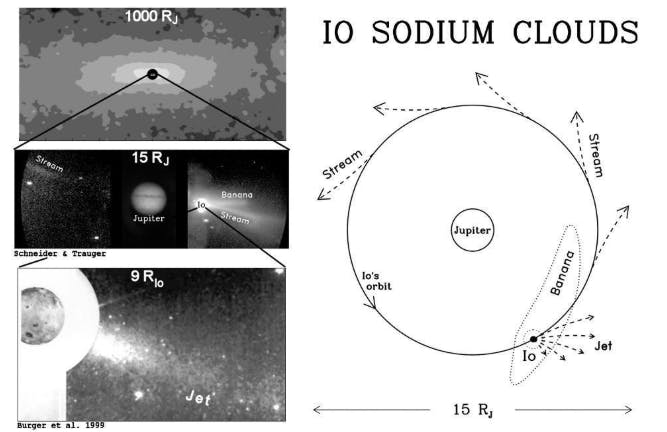Table of Links
Abstract
-
Introduction
1.1. Io as the main source of mass for the magnetosphere
1.2. Stability and variability of the Io torus system
1.3. Hypothesized volcanic mass supply events
1.4. Objective of this review
-
Review of the relevant components of the Io-Jupiter system
2.1. Volcanic activity: hot spots and plumes
2.2 Io’s bound atmosphere
2.3 Exosphere and atmospheric escape
2.4 Electrodynamic interaction, plasma-neutral collisions, and the related atmospheric loss processes
2.5. Neutrals from Io in Jupiter’s magnetosphere
2.6. Plasma torus and sheet, energetic particles
2.7 Jupiter’s aurora and connections to the Io torus
2.8 Dust from Io
-
Summary: What we know and what we do not know and 3.1 Current understanding for normal (stable) conditions
3.2 Canonical number for mass supply
3.3 Transient events in the plasma torus, neutral clouds and nebula, and aurora
3.4 Gaps in understanding, contradictions, and inconsistencies
-
Future observations and methods and 4.1 Spacecraft measurements
4.2 Remote Earth-based observations
4.3 Modeling efforts
Appendix, Acknowledgements, and References
2.5. Neutrals from Io in Jupiter’s magnetosphere
As most of the material from Io that is ultimately supplied to the plasma torus and plasma sheet in the magnetosphere comes from the neutral clouds (and not from direct ionization at Io), they carry important information about the interaction of Io with the Jovian magnetosphere and the exchange of mass. The clouds themselves also have substructure in their local densities, a consequence of the characteristics of their sources and sinks. We begin by highlighting observations of sodium (Na) and potassium (K), the two minor species most readily detectable remotely providing important tracers of Io’s neutral species’ evolution. We then highlight the current understanding of Io’s sulfur (S) and oxygen (O) clouds and how they provide the seed for Jupiter’s magnetospheric plasma. We also explain that while transient changes of Na have been observed, it is not clear yet how these are related to volcanism and the bulk neutral environment.
Previous reviews on the neutral clouds can be found as part of chapters bySchneider and Bagenal (2007) and Thomas et al. (2004).
2.5.1. Sodium and Potassium Clouds
Banana Cloud. Sodium gas that is either sputtered or chemically created near Io’s exobase at a velocity exceeding 2.3 km/s can escape the moon’s gravity. This yellow (due to the emission line at 589.0 nm) and curved in shape sodium gas cloud leading and trailing Io in its orbit is aptly termed the “banana.” This cloud is shaped by the angular momentum of the escaping gas relative to Io, and to a lesser degree by solar radiation pressure. Gas escaping from Io’s leading hemisphere exceeds Io’s orbital velocity and thus drifts radially outward from Jupiter. Gas escaping Io’s trailing hemisphere has a lower orbital velocity than Io and falls inward toward Jupiter. Near Io’s orbit, the core electron temperature of the Io plasma torus is comparable to the 5.14eV sodium ionization potential, and electron temperature increases radially from Jupiter (Bagenal, 1994). Hence, electron impact ionization truncates the banana cloud outward of about 6 Jovian radii, while sodium gas radially interior of Io’s orbit is preserved as neutral. The precise contours of where Na ionization occurs are complicated by the 0.13 RJ dawnward offset of the Io plasma torus (e.g., Schmidt et al., 2018) and by the collisional cooling of the electron population within the denser gases near Io and its wake (e.g., Dols et al., 2012).
Jet and Stream. These are defined structures of neutral sodium tied to Jupiter’s magnetic field that must be produced through ion chemistry, whereby species are first ionized and then neutralized. Either charge exchange or dissociative recombination are viable as neutralization mechanisms, but the neutralization of atomic ions via recombination with a free electron is clearly too inefficient. Dissociative recombination of a molecular ion is considered more plausible than charge exchange as the source for the neutral jet and stream, and NaCl+ has come into focus as a likely chemical pathway considering that NaCl outgassing rates are sufficient to supply the escape rates into the cloud (Lellouch et al., 2003) and NaCl is a major constituent of Io’s volcanic dust (Postberg et al., 2006).
The stream and jet are distinct in that the stream emanates from the diffuse plasma torus, while the jet emanates from Io itself. Ions in the jet are formed by chemistry tied to Io’s ionosphere, where the lifetime for dissociative recombination is less than 2 minutes. Sodium can be seen as a stream oriented along the torus equator more than 1 million km from Io (Schneider et al., 1991, Figure 15), which corresponds to a plasma transport time of several hours. It remains uncertain if the stream feature is produced by the same chemical reaction as the jet; charge exchange with Na ions in the torus to produce fast neutral Na cannot be ruled out.
Extended sodium nebula. The extended sodium nebula formed by ion chemistry in the Io-Jupiter interaction is one of the largest structures in our solar system. At times, its observable diameter can exceed 1000 RJ , an angular size of ~5.5° (which is about twelve times the diameter of a full Earth’s Moon) as viewed from Earth (Wilson et al., 2002). The distant Na nebula is thus a good target for monitoring variability in the Io-Jupiter system using small coronagraphs designed for wide-field, low surface brightness measurements (Mendillo et al., 2004). Transient brightness increases of this extended nebula have been observed relatively frequently in various studies. The long-term study by Mendillo et al. (2004) identified weaker brightenings in 1990, 1991 and 1997 and stronger brightenings in 1995 and in 1998. on, Yoneda et al. (2009, 2015) reported brightenings in 2007 and 2015 and for the latter a simultaneous change in the oxygen neutral cloud and plasma torus were monitored by Hiaski (Section 2.6). Most recently, Morgenthaler et al. (2019) reported a transient event in the sodium nebula in 2018. Hence, the sodium nebula appears to regularly undergo transient brightenings.
Potassium. The structure of the potassium clouds around Io is similar to that of sodium, where again the cloud leading Io drifts inward towards Jupiter and extends farther in longitude than gas on the trailing hemisphere (Trafton, 1981). Neutral potassium has been measured with high Doppler shifts indicative of ion chemistry, but the relative strength of its fast component is weak as compared to sodium (Schmidt, 2022; Thomas, 1996). Disk-resolved ALMA measurements show that the NaCl/KCl ratio is in the 3.5 to 10 range (Redwing et al., 2022), marginally lower than the Na/K ratio of 7 to 13 in Io’s exosphere (Brown, 2001), suggesting that Na may escape more efficiently than K. Io’s extended fast chlorine cloud presents a challenge for remote sensing measurements and remains unconstrained, but its presence can be inferred since dissociative recombination of NaCl+ would also impart kinetic energy to Cl, albeit at a lower energy due to its higher mass.
2.5.2. Bulk neutral clouds
Neutrals leave Io’s atmosphere both in molecular form as SO2 and SO (and possibly others) and in their atomic constituents S and O. The bulk atomic species have been constrained observationally to some extent, although not as much in detail as the sodium clouds. Molecules in or near Io’s orbit have not yet been measured directly and our understanding relies more on modeling work.
The sodium banana cloud has a measurable extent roughly 90º in longitude leading Io and the timescale to reach such distance is about 3 days at Io’s escape velocity. The O lifetime against electron impact ionization is at least 20 hours, and so it persists long enough to form a neutral torus wrapping entirely around Jupiter (Burger and Johnson, 2004), as shown in Figure 17 (Smith et al., 2019). Brown (1981) showed that faint electron-excited [O I] 630 nm could be seen remote from Io, leading it by nearly 90º along its orbital path. Thomas (1996) confirmed a similar [O I] brightness of 8.8R at the ansa just trailing Io. In both cases, the Doppler shift of this emission feature was at Io’s orbital velocity, which establishes that it could not be produced by O originating from an ionic chemical pathway.
Dissociative recombination of molecular ions could potentially produce fast atomic O and S neutrals analogous to the Na jet, but this has been difficult to establish given sparse observational evidence.
2.5.3. Transient changes in the neutral environment and connections
The transient brightenings regularly observed in the sodium nebula (Section 2.5.1) are commonly interpreted as being triggered by a change in volcanic activity at Io. So far, there is evidence for a transient brightening of the bulk neutral species only from the 2015 Hisaki observations of the O emissions from the neutral cloud (Koga et al., 2018a) which show near-simultaneous changes in O and Na (Yoneda et al. 2015). In other cases, a close-in-time enhancement in torus ion emission was observed (Brown and Bouchez, 1997; Yoneda et al., 2009; Tsuchiya et al. 2018 and Koga et al. 2019).
Authors:
(1) L. Roth, KTH Royal Institute of Technology, Space and Plasma Physics, Stockholm, Sweden and a Corresponding author;
(2) A. Blöcker, KTH Royal Institute of Technology, Space and Plasma Physics, Stockholm, Sweden and Department of Earth and Environmental Sciences, Ludwig Maximilian University of Munich, Munich, Germany;
(3) K. de Kleer, Division of Geological and Planetary Sciences, California Institute of Technology, Pasadena, CA 91125 USA;
(4) D. Goldstein, Dept. Aerospace Engineering and Engineering Mechanics, The University of Texas at Austin, Austin, TX USA;
(5) E. Lellouch, Laboratoire d’Etudes Spatiales et d’Instrumentation en Astrophysique (LESIA), Observatoire de Paris, Meudon, France;
(6) J. Saur, Institute of Geophysics and Meteorology, University of Cologne, Cologne, Germany;
(7) C. Schmidt, Center for Space Physics, Boston University, Boston, MA, USA;
(8) D.F. Strobel, Departments of Earth & Planetary Science and Physics & Astronomy, Johns Hopkins University, Baltimore, MD 21218, USA;
(9) C. Tao, National Institute of Information and Communications Technology, Koganei, Japan;
(10) F. Tsuchiya, Graduate School of Science, Tohoku University, Sendai, Japan;
(11) V. Dols, Institute for Space Astrophysics and Planetology, National Institute for Astrophysics, Italy;
(12) H. Huybrighs, School of Cosmic Physics, DIAS Dunsink Observatory, Dublin Institute for Advanced Studies, Dublin 15, Ireland, Space and Planetary Science Center, Khalifa University, Abu Dhabi, UAE and Department of Mathematics, Khalifa University, Abu Dhabi, UAE;
(13) A. Mura, XX;
(14) J. R. Szalay, Department of Astrophysical Sciences, Princeton University, Princeton, NJ, USA;
(15) S. V. Badman, Department of Physics, Lancaster University, Lancaster, LA1 4YB, UK;
(16) I. de Pater, Department of Astronomy and Department of Earth & Planetary Science, University of California, Berkeley, CA 94720, USA;
(17) A.-C. Dott, Institute of Geophysics and Meteorology, University of Cologne, Cologne, Germany;
(18) M. Kagitani, Graduate School of Science, Tohoku University, Sendai, Japan;
(19) L. Klaiber, Physics Institute, University of Bern, 3012 Bern, Switzerland;
(20) R. Koga, Department of Earth and Planetary Sciences, Nagoya University, Nagoya, Aichi 464-8601, Japan;
(21) A. McEwen, Department of Astronomy and Department of Earth & Planetary Science, University of California, Berkeley, CA 94720, USA;
(22) Z. Milby, Division of Geological and Planetary Sciences, California Institute of Technology, Pasadena, CA 91125 USA;
(23) K.D. Retherford, Southwest Research Institute, San Antonio, TX, USA and University of Texas at San Antonio, San Antonio, Texas, USA;
(24) S. Schlegel, Institute of Geophysics and Meteorology, University of Cologne, Cologne, Germany;
(25) N. Thomas, Physics Institute, University of Bern, 3012 Bern, Switzerland;
(26) W.L. Tseng, Department of Earth Sciences, National Taiwan Normal University, Taiwan;
(27) A. Vorburger, Physics Institute, University of Bern, 3012 Bern, Switzerland.





















